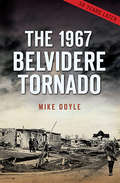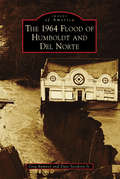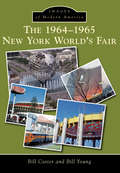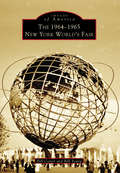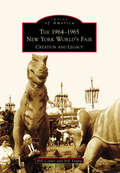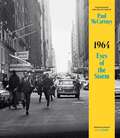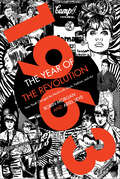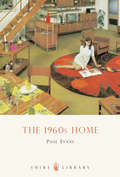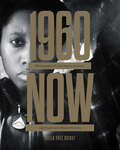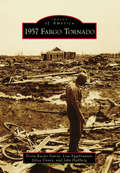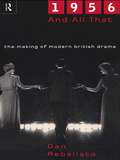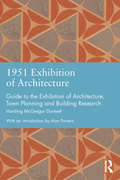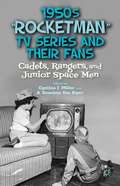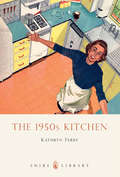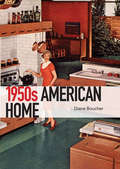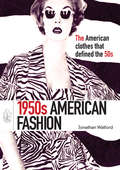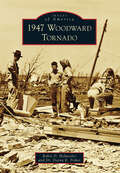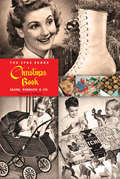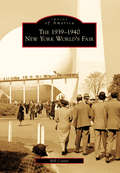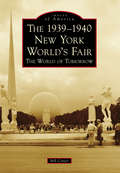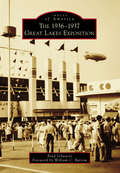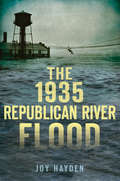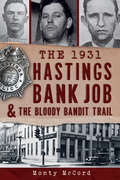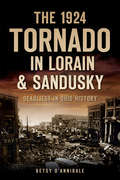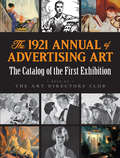- Table View
- List View
1967 Belvidere Tornado, The: A 40-year Anniversary Perspective (Disaster)
by Mike DoyleClaiming the lives of seven adults and seventeen children, the Belvidere tornado struck the most vulnerable at the worst possible time: just as school let out. More than five hundred people suffered injuries. New interviews and fascinating archival history underscore the horrific drama, as well as the split-second decisions of victims and survivors that saved their families and neighbors. Since the tragedy, three more devastating tornadoes have further defined Boone County’s resilience: Poplar Grove in 2008, Caledonia in 2010 and Fairdale in 2015.
1964 Flood of Humboldt and Del Norte, The
by Greg Rumney Dave Stockton Jr.The 1964 flood in the Eel and Klamath Rivers drainages represents an extreme weather event. Both the Northern California and Southern Oregon coasts are host to many floods, but the 1964 flood stands out as a representation of the "perfect storm." Three events occurred that led to the flood. First, a cold front moved in and dropped several feet of snow. Second, a warm front called the "pineapple connection" moved in and released lots of rain while melting the snowfall--local measurements varied from 20 to 32 inches of rainwater in three days. And third, the highest tide of the year had backed up debris and water for several miles. At its peak, the Eel River was discharging more than 800,000 cubic feet per second. Another contributing factor was that besides being one of the fastest rising and falling rivers in the world, the Eel River has the heaviest sediment load second only to the Yellow River in China.
1964-1965 New York World's Fair, The: Creation And Legacy (Images of Modern America)
by Bill Cotter Bill YoungAdvertised as the "Billion-Dollar Fair," the 1964-1965 New York World's Fair transformed a sleepy park in the borough of Queens into a fantasy world enjoyed by more than 51 million visitors from around the world. While many countries and states exhibited at the fair, the most memorable pavilions were built by the giants of American industry. Their exhibits took guests backward and forward in time, all the while extolling how marvelous everyday life would be through the use of their products. Many of the techniques used in these shows set the standard for future fairs and theme parks, and the pavilions that housed them remain the most elaborate structures ever built for an American fair. The 1964-1965 New York World's Fair showcases the beauty of this international spectacular through rare color photographs, published here for the first time.
1964-1965 New York World's Fair, The: Creation And Legacy (Images of America)
by Bill Cotter Bill YoungThe 1964-1965 New York World's Fair was the largest international exhibition ever built in the United States. More than one hundred fifty pavilions and exhibits spread over six hundred forty-six acres helped the fair live up to its reputation as "the Billion-Dollar Fair." With the cold war in full swing, the fair offered visitors a refreshingly positive view of the future, mirroring the official theme: Peace through Understanding. Guests could travel back in time through a display of full-sized dinosaurs, or look into a future where underwater hotels and flying cars were commonplace. They could enjoy Walt Disney's popular shows, or study actual spacecraft flown in orbit. More than fifty-one million guests visited the fair before it closed forever in 1965. The 1964-1965 New York World's Fair captures the history of this event through vintage photographs, published here for the first time.
1964-1965 New York World's Fair, The: Creation and Legacy (Images of America)
by Bill Cotter Bill YoungWhen the gates of the 1964-1965 New York World's Fair swung open on April 24, 1964, the first of more than 51 million lucky visitors entered, ready to witness the cutting edge of worldwide technology and progress. Faced with a disappointing lack of foreign participants due to political contention, the fair instead showcased the best of American industry and science. While multimillion-dollar pavilions predicted colonies on the moon and hotels under the ocean, other forecasts, such as the promises of computer technology, have surpassed even the most optimistic predictions of the fair. The 1964-1965 New York World's Fair: Creation and Legacy uses rare, previously unpublished photographs to examine the creation of the fair and the legacies left behind for future generations.
1964: Eyes of the Storm
by Paul McCartney“Millions of eyes were suddenly upon us, creating a picture I will never forget.” —Paul McCartney. <p><p>Taken with a 35mm camera by Paul McCartney, these largely unseen photographs capture the explosive period, from the end of 1963 through early 1964, in which The Beatles became an international sensation and changed the course of music history. <p><p>Featuring 275 images from the six cities—Liverpool, London, Paris, New York, Washington, D.C., and Miami—of these legendary months, 1964: Eyes of the Storm also includes: <p>• A personal foreword in which McCartney recalls the pandemonium of British concert halls, followed by the hysteria that greeted the band on its first American visit <p>• Candid recollections preceding each city portfolio that form an autobiographical account of the period McCartney remembers as the “Eyes of the Storm,” plus a coda with subsequent events in 1964 <p>• “Beatleland,” an essay by Harvard historian and New Yorker essayist Jill Lepore, describing how The Beatles became the first truly global mass culture phenomenon <p><p>Handsomely designed, 1964: Eyes of the Storm creates an intensely dramatic record of The Beatles’ first transatlantic trip, documenting the radical shift in youth culture that crystallized in 1964. <p><p>“You could hold your camera up to the world, in 1964. But what madness would you capture, what beauty, what joy, what fury?” —Jill Lepore <p> <b>New York Times Bestseller</b>
1963: How Youth Changed the World with Music, Fashion, and Art
by Robin Morgan Ariel LeveBeginning in London and ricocheting across the Atlantic, 1963: The Year of the Revolution is an oral history of twelve months that changed our world—the Youth Quake movement—and laid the foundations for the generation of today.Ariel Leve and Robin Morgan's oral history is the first book to recount the kinetic story of the twelve months that witnessed a demographic power shift—the rise of the Youth Quake movement, a cultural transformation through music, fashion, politics, theater, and film. Leve and Morgan detail how, for the first time in history, youth became a commercial and cultural force with the power to command the attention of government and religion and shape society.While the Cold War began to thaw, the race into space heated up, feminism and civil rights percolated in politics, and JFK’s assassination shocked the world, the Beatles and Bob Dylan would emerge as poster boys and the prophet of a revolution that changed the world.1963: The Year of the Revolution records, documentary-style, the incredible roller-coaster ride of those twelve months, told through the recollections of some of the period’s most influential figures—from Keith Richards to Mary Quant, Vidal Sassoon to Graham Nash, Alan Parker to Peter Frampton, Eric Clapton to Gay Talese, Stevie Nicks to Norma Kamali, and many more.
The 1960s Home
by Paul EvansThe 1960s witnessed a sustained period of economic growth, consumer spending and stable employment. This hitherto unknown prosperity enabled a market growth in levels of owner occupation and a subsequent boom in the sale of household furnishings and luxury goods. The 1960s Home looks at the styles and fashions in domestic housing and interiors between 1960 and 1970. Although this period has received increasing attention in recent years, much of it has been concentrated on progressive and exclusive design rather than on the furniture and furnishing of the 'average' home.From the Trade Paperback edition.
#1960Now: Photographs of Civil Rights Activists and Black Lives Matter Protests
by Alicia Garza Sheila Pree BrightThe fight for equality continues, from 1960 to now. Combining portraits of past and present social justice activists with documentary images from recent protests throughout the United States, #1960Now sheds light on the parallels between the 1960s Civil Rights Movement and the Black Lives Matter movement of today. Shelia Pree Bright's striking black-and-white photographs capture the courage and conviction of '60s elder statesmen and a new generation of activists, offering a powerful reminder that the fight for justice is far from over. #1960Now represents an important new contribution to American protest photography.
1957 Fargo Tornado (Images of America)
by Trista Raezer-Stursa Lisa Eggebraaten Jylisa Doney John HallbergOn the evening of June 20, 1957, a tornado ripped through Fargo, North Dakota. It caused the deaths of seven children and five adults and left 116 injured. The tornado destroyed 359 buildings and damaged 2,543 more. The nine-mile path of destruction covered over 66 blocks in town, leaving more than 2,000 people homeless and causing approximately $20 million worth of damage. Following the tornado, first responders quickly united to aid those in need, setting up disaster headquarters, finding shelter for over 600 people, and distributing more than 100 tons of clothing and bedding. Dr. Tetsuya Fujita, a meteorologist, studied the Fargo tornado when creating the Fujita scale (F-scale) and later rated it an F5, the most destructive rating. Images of America: 1957 Fargo Tornado, shines a light on the tornado's destruction and the rebuilding of a united and vibrant community.
1956 and All That: The Making of Modern British Drama
by Dan RebellatoIt is said that British Drama was shockingly lifted out of the doldrums by the 'revolutionary' appearance of John Osborne's Look Back in Anger at the Royal Court in May 1956. But had the theatre been as ephemeral and effeminate as the Angry Young Men claimed? Was the era of Terence Rattigan and 'Binkie' Beaumont as repressed and closeted as it seems? In this bold and fascinating challenge to the received wisdom of the last forty years of theatrical history, Dan Rebellato uncovers a different story altogether. It is one where Britain's declining Empire and increasing panic over the 'problem' of homosexuality played a crucial role in the construction of an enduring myth of the theatre. By going back to primary sources and rigorously questioning all assumptions, Rebellato has rewritten the history of the Making of Modern British Drama.
1951 Exhibition of Architecture: Guide to the Exhibition of Architecture, Town Planning and Building Research (Studies in International Planning History)
by Harding McGregor DunnettThe Festival of Britain is perhaps best known for its South Bank Exhibition promoting British science and art to the post-war world, but one of the most important elements was the Architecture Exhibition, based in Poplar in East London. This exhibition was used to demonstrate the principles of modern town planning that had been laid out by Abercrombie, in particular in his County of London Plan. The project was named after George Lansbury, the Labour MP, London County Council (LCC) member and Poplar councillor. It was an effective demonstration of planning ideas adopted since the 1930s by influential planners, taking the village as a model and retaining the terraced house as a housing option among medium rise flats. Small squares and open spaces were favoured, with paved pedestrian spaces, all at lower than pre-war densities. The guide is revealing of the broader thinking in English planning in the mid century. It provides an opportunity for looking at conflicts among advocates of different planning ideas in the period of reconstruction and the move by architects to regain control of LCC housing from the Valuer’s Department. It offers the model of integrated professional specialisms that was seen as central to Modernism’s mission. It is also an opportunity to describe in more detail the interaction of different professions, including, for example, a sociologist, employed by the LCC in the creation of a model for reconstruction.
1950s "Rocketman" TV Series and Their Fans
by Cynthia J. MillerThe fourteen essays featured here focus on series such as Space Patrol, Tom Corbett, and Captain Z-Ro, exploring their roles in the day-to-day lives of their fans through topics such as mentoring, promotion of the real-world space program, merchandising, gender issues, and ranger clubs - all the while promoting the fledgling medium of television.
The 1950s Kitchen
by Kathryn FerryThe 1950s was the first great age of the modern kitchen: labor-saving appliances, bright colors and the novelty of fitted units moved the kitchen from dankness into light, where it became the domain of the happy housewife and the heart of the home. Formica - a new space-age material - decorated with fashionable patterns topped sleek cupboards that contained new classic wares such as Pyrex and 'Homemaker' crockery, and the ingredients for 1950s British staples: semolina, coronation chicken and spotted dick. Electricity entered the kitchens of millions, and nowhere in the home was modern technology and modern design more evident. Bold color, clean lines and stainless steel were keynotes of the decade, and it is no surprise that 1950s kitchen style is now the height of fashion once again, with names like Cath Kidston picking up on the best of '50s kitchen kitsch, and manufacturers like Dualit, Kitchen Aid and Aga doing healthy business with retro appliances. This book - a celebration of cooking, eating and living in the 1950s kitchen - is a feast of nostalgia, and a mine of inspiration for anyone wanting to recreate that '50s look in their own home.From the Trade Paperback edition.
The 1950s American Home
by Diane BoucherThis title explores what life was like in the 1950s American home. An age of optimism, it is about living the American Dream and how this was achieved, changes in the home, new convenience technology, new ways of living. From Ranch House to American Modernism to affordable homes in the suburbs, this was how to live the good life in an era of unprecedented prosperity and opportunity.From the Trade Paperback edition.
1950s American Fashion
by Jonathan WalfordThe 1950s was the first decade when American fashion became truly American. The United States had always relied on Europe for its style leads, but during World War II, when necessity became the mother of invention, the country had to find its own way. American designers looked to what American women needed and found new inspirations for American fashion design. Sportswear became a strength, but not at the expense of elegance. Easy wear materials were borrowed for producing more formal clothes, and versatile separates and adaptable dress and jacket suits became hallmarks of American style. This book follows the American fashion industry, from New York's 7th Avenue to the beaches of California in search of the clothes that designed 1950s American fashion.
1947 Woodward Tornado (Images of America)
by Robin D. Hohweiler Dr. Deena FisherThe 1947 Woodward Tornado remains the deadliest tornado in Oklahoma history, leaving more than 100 people dead and nearly 1,000 seriously injured. The tornado struck the city of Woodward under cover of darkness and without warning at 8:42 p.m. on April 9, 1947. The storm left in its wake hundreds of stories of tragic loss, devastation, and even mysteries that remain unsolved. These include the three unidentified girls--one as young as six months--whose bodies have remained unclaimed, as well as the mystery of what happened to Joan Gay Croft, a girl who disappeared from the local hospital on the night of the storm. Croft's disappearance was featured in an episode of the television show Unsolved Mysteries in the early 1990s. There is also the oft-overlooked story of those who took up residence (some for more than a year) in "Tornado Town" west of the city and found some glimmer of hope in an otherwise hopeless situation.
The 1942 Sears Christmas Book: Create Your Own Illustrated Winter Wonderland With Tantalizing Scented Markers And Delectable Stickers In One Holiday-filled Activity Book (Sweet Scentsations Ser. #Vol. 4)
by Sears, Roebuck and Co.For generations, the much-anticipated arrival of the Sears gift catalog signaled the start of the holiday season. This faithful facsimile of the retailer's 1942 Christmas edition offers a nostalgia-inducing chance to relive those bygone years, when turning the pages of a catalog could excite young minds with dreams of a shiny toy truck or a new doll under the tree.A unique collectible, The 1942 Sears Christmas Book also provides an interesting look at how merchandise has evolved over the years. In 1942, Sears shoppers could purchase toys as well as housewares, clothes, furniture, candy, and gifts to send to servicemen (all at prices that now seem astonishingly low). The wartime catalog even includes information about the importance of saving scrap metal for munitions and encourages readers to buy war bonds.A new Introduction by Ben B. Judd, Jr., PhD, the former chair of the University of New Haven Department of Marketing and International Business, provides thought-provoking insights into the catalog's importance to rural America and the recent downfall of the retail giant.
1939-1940 New York World's Fair, The
by Bill CotterAfter enduring 10 harrowing years of the Great Depression, visitors to the 1939-1940 New York World's Fair found welcome relief in the fair's optimistic presentation of the "World of Tomorrow." Pavilions from America's largest corporations and dozens of countries were spread across a 1,216-acre site, showcasing the latest industrial marvels and predictions for the future intermingled with cultural displays from around the world. Well known for its theme structures, the Trylon and Perisphere, the fair was an intriguing mixture of technology, science, architecture, showmanship, and politics. Proclaimed by many as the most memorable world's fair ever held, it predicted wonderful times were ahead for the world even as the clouds of war were gathering. Through vintage photographs, most never published before, The 1939-1940 New York World's Fair recaptures those days when the eyes of the world were on New York and on the future.
The 1939-1940 New York World's Fair: The World of Tomorrow (Images of America)
by Bill CotterThe World of Tomorrow
The 1936-1937 Great Lakes Exposition (Images of America)
by Brad Schwartz William C. BarrowThe Great Lakes Exposition was held in Cleveland during the summers of 1936 and 1937, drawing seven million visitors over its two-year run. The exposition was intended to observe the city's centennial anniversary and to celebrate the Great Lakes Region. It was also hoped that it would help lift the city's economy out of the Great Depression. The exposition boasted a staggering array of ever-changing national-level attractions and feature events. In a single day, exposition visitors could experience the latest technological innovations; see a world-class aquatics show; watch a Shakespearean play; ride in a blimp; and hear the music, taste the food, view the architecture, and experience the culture of 40 of the world's countries.
The 1935 Republican River Flood (Disaster)
by Joy HaydenOn May 31, 1935, a storm system surged along the Republican River, bursting its banks in a matter of minutes with a roar that could be heard miles away. The greatest flood to hit the tri-state area of Colorado, Kansas and Nebraska, it left behind a landscape rearranged beyond recognition and claimed more than one hundred casualties. However, amid all the destruction and sorrow, amazing acts of heroism and unwavering courage were reported throughout the valley. Author Joy Hayden reveals the historic disaster and the steadfast resolve of those who witnessed it.
The 1931 Hastings Bank Job & the Bloody Bandit Trail
by Monty MccordIn February 1931, "Mr. & Mrs. Robert Hendricks" and three others tied up fourteen employees at the Hastings National Bank and walked away with over $27,000 from the vault. They then returned home to plan a robbery of the First National Bank for the following day. Even though police quickly surrounded the house, the robbers managed to capture all eleven officers on the scene and make a getaway. Retired police lieutenant and historian Monty McCord recounts the crime and the grisly aftermath in the first account of the heist ever to be published.
The 1924 Tornado in Lorain & Sandusky: Deadliest In Ohio History (Disaster)
by Betsy D'AnnibaleJune 28, 1924, dawned hot and sunny, with fluffy white clouds hovering over a blue and inviting Lake Erie. For two Ohio communities, Lorain and Sandusky, the day ended in unimaginable disaster. In the late afternoon, the blue sky turned dark, and the wispy white puffs morphed into a mass of black thunderclouds as a monster formed on the lake. An F4 tornado, unexpected and not understood, was born from a thunderstorm on the now turbulent waters of Lake Erie. It charged ashore, smashing into Sandusky, retreated again to the lake and then headed east before turning abruptly south to make landfall in Lorain. Before the massive funnel lifted, it would destroy a city, create death records still unbroken and change the lives of thousands of people.
The 1921 Annual of Advertising Art: The Catalog of the First Exhibition Held by The Art Directors Club
by Art Directors ClubThe publishing boom of the early twentieth century led to an entirely new vocation, that of art direction for editorial publications and advertising. In 1921, the recently formed Art Directors Club resolved to show that their profession involved more than just signage for selling products. Their exhibition of paintings and drawings, intended to prove their work worthy of artistic consideration, was judged by a jury that featured some of the era's most distinguished names in illustration and art, including Ashcan School painter Robert Henri; Charles Dana Gibson, creator of the "Gibson Girl"; and outstanding New York artist Joseph Pennell, among others. This reproduction of the exhibition's catalog offers a generous selection of more than 300 halftone images, accompanied by an appendix of the ads' corresponding sources. New to this edition are added pages of brilliant color reproductions of a selection of the best materials. Entries by leaders in the field include J. C. Leyendecker's ads for Arrow shirts, Maxfield Parrish's Mazda Lamp calendar pages, Franklin Booth's line art, and contributions by Norman Rockwell, Edward Penfield, N. C. Wyeth, and other luminaries. Students of art, illustration, and advertising as well as professional illustrators, historians, and anyone with an appreciation of advertising art will find this volume a richly evocative source of historic commercial art.
